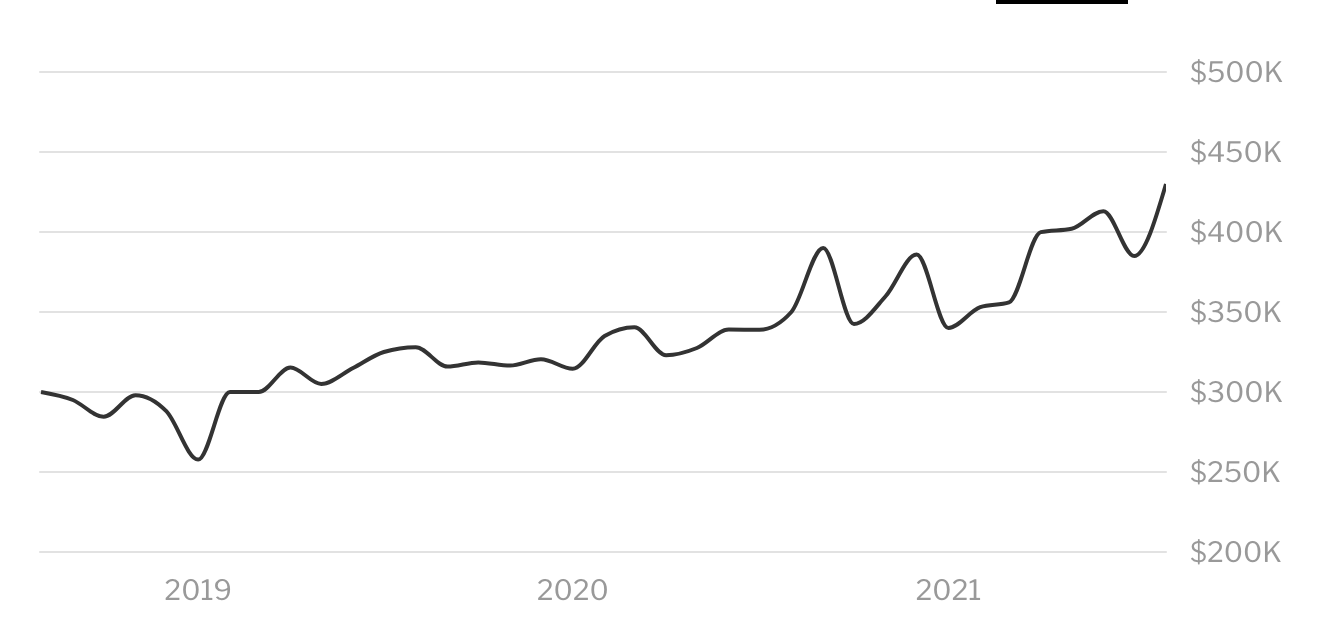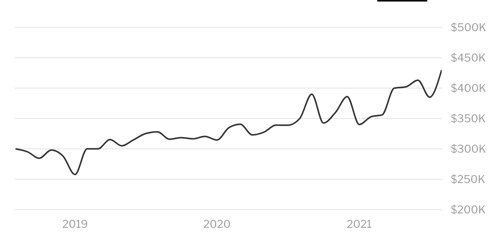Thinking about moving to Asheville, North Carolina? Nestled in the stunning Blue Ridge Mountains, Asheville has earned a number of nicknames that celebrate its natural beauty: Paris of the South, San Francisco of the East, Land of the Sky and New Age Mecca, among others.
But is Asheville, NC expensive to live in? Here, we’ll help you decide whether to rent or buy in the city, including key stats on the average rent and mortgage in Asheville as well as things to consider when you’re touring homes.
1. What Is Asheville Like?
Asheville is a riverside city — the 12th-largest city in North Carolina. It boasts a rich arts scene and historic architecture surrounded by more than 800,000 acres of pristine wilderness for unbeatable scenic vistas. Whether you’re attracted to the city’s small-town charm or opportunities for world-class exploration and music, Asheville has plenty to offer for city newcomers and long-time Carolina residents alike.
| Related: Jobs, restaurants, the best neighborhoods, outdoor activities and more — check out The Ultimate Guide to Visiting (or Living in) Asheville, NC. |


The average housing price in Asheville, NC from 2019 to 2021.
2. What’s the Average Home Price in Asheville, NC?
The median cost of a home in Asheville, NC, according to housing market data from August 2021, is $430,000 — 22.9 percent higher than it was last year. Compared to the general U.S. median (which is $380,271), homes in Asheville are about 11.6 percent more expensive. Here are some other important data points to consider:
- Median days on market: 42
- Homes sold above list price: 39.2 percent
- Homes with price drops: 12.2 percent
During the pandemic, out-of-town interest in Asheville skyrocketed, resulting in a game-changing surge of growth in property sales. In fact, agent Justin Purnell claimed that 80 percent of his buyers were coming from out of town, and according to Asheville-based real estate agent Alexandra Schrank, “‘If your budget is $300,000 or lower, it is almost impossible to find anything.’” (These are both from a July 2021 article in “Mountain Xpress,” a local print and online newspaper.)
With Asheville’s vibrant food, music and art scene, as well as the temperate climate created by the shield of the Blue Ridge mountains, which keep temperatures warmer in the winter and cooler in the summer than some of Asheville’s regional neighbors, it’s no wonder that residents of cities in California, New York and other expensive states are flocking to grab homes before prices continue to climb.
A Typical Mortgage Payment
For a $430,000 home with a 30-year loan and 3.03 percent interest rate (the current national average, as of September 2021), you’ll be paying a 20 percent down payment of $86,000 and monthly mortgage payments of $1,804, including homeowner’s insurance, property taxes and HOA fees. Note that the median household income in Asheville as of 2019 is $49,930.
| Did you know? In Asheville, 47 percent of all occupied homes are owner-occupied, while 52 percent are renter-occupied. |
Reasons to Buy in Asheville, NC
Asheville is a great place to buy a house, but the market is hot and waiting around may only make you miss a great opportunity. Here are a few reasons to buy instead of rent:
- Booming housing market. During the pandemic, out-of-town interest in Asheville skyrocketed, resulting in a game-changing surge of growth in property sales. In fact, agent Justin Purnell claimed that 80 percent of his buyers were coming from out of town, and according to Asheville-based real estate agent Alexandra Schrank, “‘If your budget is $300,000 or lower, it is almost impossible to find anything.’” If you’re going to get in, now’s the time.
- Happy locals. In 2018, Asheville was rated the “happiest city in North Carolina.” If you know that NC is where you want to settle down and plant your roots, Asheville’s where you’ll find the happiest locals in the state.
3. What’s the Average Rent in Asheville, NC?
The average rent in Asheville, NC is $1,463, as of August 2021 — a 20 percent increase since August 2020. This is cheaper than the average mortgage, which is about $400 more per month. Here are some other key stats:
- Average apartment size: 979 square feet (close to the one-bedroom average)
- Breakdown of monthly rent across properties:
- 501-$700 = 2 percent
- $701-$1,000 = 4 percent
- $1,001-$1,500 = 57 percent
- $1,501-$2,000 = 27 percent
- >$2,000 = 9 percent
Here is the average rent across 10 neighborhoods in Asheville, NC (from high to low):
- Chestnut Hills: $1,480
- Claxton: $1,480
- Downtown Asheville: $1,480
- Wyntree: $1,432
- Kenilworth: $1,395
- Woodland Hills: $1,309
- Cedar Ridge: $1,305
- Mountain Meadows: $1,252
- Worthwood: $1,203
- Grandview: $1,199
Reasons to Rent in Asheville, NC
Asheville is a great place to buy a house, but the market is hot and waiting around may only make you miss a great opportunity. Here are a few reasons to buy instead of rent:
- Struggling job market. During 2020, unemployment in Asheville rose from around three percent to a staggering 20.5 percent, with more than 10,000 people out of work (especially those in the hospitality industry). Unless you work remotely, finding a job in Asheville may be tough, and with increasing house prices, renting might be a safer option until the city gets back on its feet.
- Acclimating to mountain living. Living in the mountains can give you access to fresh air and water and incredible views, but it’s not for everyone. Renting can give you time to adjust to Asheville’s mountain location and see if it’s something you’d like in the long run.
4. 6 Things to Consider If You’re Buying a House in Asheville
When you buy a house in Asheville, you’ll need to factor in additional costs based on seasonal weather changes, geographic risks and other potential damages.
Wildfire Insurance
Since many Asheville homes are located in or near the woods, you should definitely consider getting wildfire insurance, or checking your homeowner’s insurance policy to see if it covers wildfire damage.
Septic Maintenance
Most of the homes in Asheville are on the well and septic system. This comes with the perk of having no monthly water bill, but you’ll want to budget at least $500 per year for inspections, maintenance costs and the like.
Flooding
Asheville receives an average of 44 inches of rain a year, which is six inches more than the national average. Find out if your dream home is in a flood zone by checking the North Carolina Flood Risk Information System, and buy flood insurance if it is — floods are rarely covered in homeowner’s insurance policies. Be sure to factor clearing debris out of storm drains into your cleaning schedule, and keep a stocked emergency kit in your home at all times.
| Tip: Download our Ultimate Cleaning Checklist to help you keep track of — and complete — your routine tasks. |
Central Air
In general, Asheville doesn’t get as hot or cold as nearby cities, due to its high elevation of 2,134 feet above sea level and surrounding mountain barrier. In fact, many older homes don’t come with central air, and rely on oil heating or electric baseboard heating instead. If this is an issue for you, be sure to factor in the costs of upgrading to central heating and cooling.
Mold and Radon
Asheville can get muggy as humidity levels rise in spring and summer, leading to increased dampness inside of your home. In addition to budgeting for a dehumidifier, you’ll need to be sure to carefully examine the rooms, basement, attic and other spaces for lurking mold, and buy testing kits if you’re worried that your home may have hidden mold behind the walls. You can learn more about the symptoms of mold exposure here.
Asheville homes are also prone to radon exposure, which can have harmful effects on your health. Read more about how to test a potential home (or apartment) for radon.
Storm Risk and Heat Risk
The city experiences a high storm risk, with about eight two-day storms per year that generate around two inches of rain, though this is expected to increase six-fold by 2050. As far as heat risk, there are, on average, eight “hot” days per year when the temperature climbs above 89 degrees Fahrenheit, though by 2050 this number is also expected to increase six-fold.









